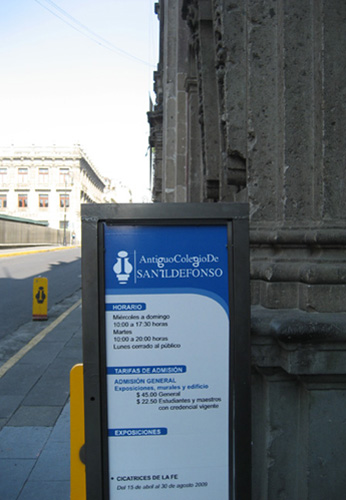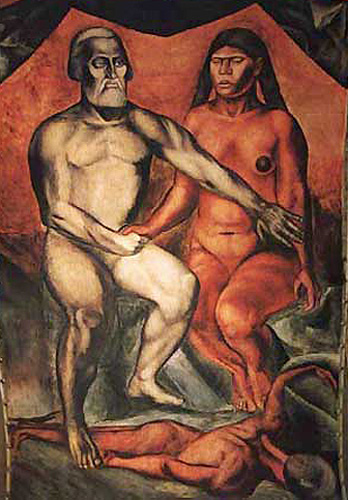La Malinche / Dª Marina / Malinali / Malintzin
1498-1505 This Aztec woman's name at birth probably was Malintzin or Malinali
or Malinche (Spanish version). She was born in Painal,
Her
father was the Aztec cacique (chief
or leader) of the town.
When
she was a little girl, Malinali's mother died. Her
father remarried, but when Malinali's stepmother died, her father sold his
daughter to merchants from Xicalanco. These
merchants in turn sold Malinali to other merchants from Putun-Chan, which is
located in the Mayan region of Chokan-Putun (in the region of
1519 12 March: the Mayan cacique of Putun-Chan gave Malinali and 20 other young woman to
Cortés as a gift as a chieftain gives gifts to a guest. By such gifts the cacique sought to buy peace and goodwill
from Cortés and his Spanish conquistadors. Cortés
took Malinali as his mistress. (Cortés' wife was still in Cuba.)
When Cortés and his forces
arrived at
At
Veracruz, Jerónimo de Aguilar–who had been rescued from the Mayas and who spoke
Spanish and Maya–noticed that Malinali spoke both Náhuatl (the Aztecs’
language) and Maya. Armed with this knowledge, Cortés took Malinali
back. (Aguilar had learned
Maya during the 8 years he had lived in Yucatán, 1511-1519.)
The
Spaniards heard Malinali's name as "Malinche". (There are other
interpretations of her name including the idea that it refers to her birth
day.)
Malintzin
/ Malinali / Malinche learned Spanish quickly.
Meanwhile Puertocarrero returned
to Castile, Spain; he was a direct representative or agent (procurador) for
Cortés' relations with king Carlos I/V of Spain. (Nominally, Cortés was under
the jurisdiction of Governor Velázquez of
1519-1521 Cortés, his Spanish soldiers, and thousands of native allies,
with the aid of Malinali, conquered Tenochtitlán and the entire Aztec empire.
1519-1524 Cortés and Malinche became inseparable, doing everything and
going everywhere together. She was his concubine and he became known as
"el Señor Malinche, el Malinche, el
hombre de Malinche" (Mr. Malinche, the Malinche, Malinche's man). She
taught him everything she knew about the Mesoamerican people, their languages,
beliefs, psychology, history, myths, fears, and customs.
1522 A son was
born to Malinali and Cortés. The
boy was baptized as Martín Cortés.
Malinche
/ Malinali was baptized and changed her name to
1524 Cortés, whose wife joined him in Mexico, then had
Marina marry one of his lieutenants, Juan Jaramillo, because the later was
single and Cortés wanted to appear to be a faithful Catholic, and he wanted
Malinali to be a proper married woman according to Catholic dogma. (Cortés wife
had a difficult personality and they were not a happy couple, to say the least.
Jaramillo had been a captain of one of the ships the Spaniards used to cross
1524-1528 Marina received honor, social stature, respect, dignity in the
newly conquered city of Tenochtitlán-Mexico City. She was given the official
title of Doña Marina (Lady Marina).
1528 Jaramillo and Doña Marina acquired the former
pleasure estate owned and occupied by Moctezumo (Motecuhzoma), which was near
Chapultepec. Nowadays it is in Mexico City’s neighborhood (la
colonia) of San Angel, which is and always has been a high class
neighborhood in Mexico City. (The address is 95 Calle República de Cuba.)
Jaramillo was elevated to the
social status of the grandees (los
grandes) of México; he served in the city hall, he was a royal procurador, etc.
A
daughter baptized as María was born to Doña Marina and Jaramillo. Later María married Luis de Quesada.
1528-1550 Sometime during these years Doña Marina died.
La Malintzin / Malinche /
Malinali / Doña Marina is considered in Mexico as one of the traitors of the
Mexican people—all Mexican people, natives, mestizos,
blacks, etc. The word masculine and feminine forms of the word malinche are synonymous with traitor.
Even so, her name (Malinche) has been given to many geographical places in
Sometimes it is not remembered that she (Malinali)
was first betrayed by her own father. Note, however, that when Cortés placed
Malinche directly alongside himself, when he was seen constantly in public in
her presence, when he consulted her about all strategic and tactical matters,
Cortés and she placed themselves in direct opposition to the engrained Mexican
and indigenous patriarchal order. This near egalitarianism between Cortés and
Doña Marina was due, of course, to Cortés military needs. But it is also due to
a certain, though relative, acceptance of a woman as a man's equal, which, in
part, comes from Hispanic customs. The most obvious example of this male-female
egalitarianism, which was fully accepted and even applauded by Spaniards in the
early Renaissance are the Catholic Monarchs, Isabel I of Castile and Fernando V
of Castile/Aragón. In part, the persistence of the extreme negative connotation
of malinchismo parallels the
persistence of Mexican machismo,
which, therefore, can be seen to have existed both in the Aztec period and in
the post-Conquest period.
No extant sixteenth-century painting of Malinali has
been preserved. Various eye-witness sources said that she was beautiful for
very pretty. In the early twentieth century, attention was focused on her as
the embodiment of the oppressed—violated, even, raped—indigenous people of
Mexico, and, as mentioned above, her name became a famous Mexico curse word as
Mexican national pride began to surge in the aftermath of the Mexican
Revolution (1910-1920). Not particularly wishing to prejudice your own imagined
image of her, nevertheless, it is important to see at least one prominent version
of how she was viewed in relationship to Cortés in the 20th century.
The following shows a mural entitled “Cortés and Malinche” (1926) by José
Clemente Orozco in the San Ildefonso Museum at 16 Justo Sierra street in downtown
Mexico City:
|
|
 |
Two brief passages from a book by Analisa Taylor (Indigeneity in the Mexican Cultural
Imagination: Thresholds of Belonging. Tucson: The University of Arizona
Press, 2009) are cited here by way of tying together several humanities themes
that link sixteenth-century events, especially in Mexico, with
twenty-first-century trends. Both passages are from Taylor’s chapter on “From
Malinche to Matriarchal Utopia: Gendered and Sexualized Visions of Indigeneity”
(82-104).
(1) However, in Mexico’s current
political climate, mestizo nationalism as an ideology capable of shaping social
imperatives is clearly at an impasse. Two interrelated factors have rendered
this ideology anachronistic in times of globalization: first, the emergence in
recent decades of indigenous movements for autonomy have put pressure on the
state to both recognize Mexico as a multiethnic nation and grant collective
rights to indigenous communities; and second, the federal government has
dismantled its populist economic and social development model in favor of an
export-oriented, social austerity model as a means of reducing the mountains of
foreign debt the nation has incurred over the past four decades. The bottom
line here is that even as women’s economic burdens have shifted in these times,
such that work outside the home is no longer an option but an imperative,
mainstream representations of women’s social roles have remained anchored in
the narratives of mestizo nationalism (92).
(2) Within the [dominant narratives
of Mexican national identity], the figure of Malinche has taken on a notoriety
that stretches far beyond her historical role in the sixteenth-century conquest
of central Mexico. As Cortés’s multilingual interpreter, consul, and mother to
his child, Malinche has been invoked in twentieth-century cultural production
as the archetypal abject mother of a modern mestizo nation. In locating the
origins of modern Mexico in the sexual union of the historical figures of
Malinche and Hernán Cortés, mestizo nationalist imaginings negate the
multiethnic composition of pre- and post-conquest Mesoamerican society. At the
same time, they buttress a series of binary oppositions in which the feminine
is associated with indigeneity and subjugation while the masculine is
associated with hispanicity and conquest. As an object of scorn, her name,
which isn’t really even her name, has been invoked to negate the agency of
indigenous women in Mexican society. The historical figure of Malinche is
conjured up today when one is accused of being a malinchista, of selling one’s people out to foreign interests, as
it implies accepting subaltern status in exchange for a modicum of personal
benefit in the context of colonial or neocolonial domination” (100).



